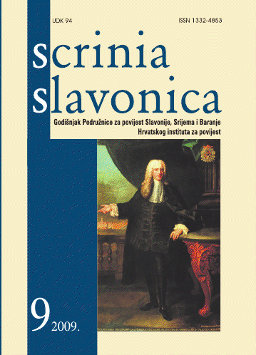Graditeljska baština zapadne Slavonije nestala u 19. i 20. stoljeću
The architectural heritage of Western Slavonia vanished in the 19th and 20th century
Author(s): Filip ŠkiljanSubject(s): History
Published by: Hrvatski institut za povijest
Keywords: Western Slavonia; Middle Ages; Catholic churches; Orthodox churches; castles; Novska; Nova Gradiška; Pakrac; Daruvar; Grubišno Polje; Virovitica; Slatina.
Summary/Abstract: The author of the paper discusses medieval and early modern edifices in Western Slavonia (the territory of former municipalities Podravska Slatina, Virovitica, Grubišno Polje, Daruvar, Novska, Nova Gradiška, and Pakrac) that have completely vanished. The introduction provides a short overview of the borders of Western Slavonia and the paper’s methodology, followed by an individual analysis of each of the aforementioned zones, with a list of individual edifices that disappeared in the 19th and 20th century. The focus is on medieval forts and Catholic and Orthodox churches. Architectural heritage vanished due to wars and negligence of the local population. The paper is based on verbal statements from the local population, field research, and study of topographic maps, literature, archival materials, and materials held by the conservation boards in Sisak, Bjelovar, Požega, and Zagreb. This short overview of monuments in Western Slavonia that completely vanished in the 19th and 20th century is only the beginning of a much more comprehensive research that is supposed to encompass a far broader territory and a far longer time period (peripheral areas – the Požega and Orahovica zones – should be included in Western Slavonia). Archeologists have already completed the pioneer tasks, reconnoitering the field and cataloguing archeological localities. Now it is up to historians (whose work has already been started in some parts of Western Slavonia) and arts historians to do their part of the work. The complete knowledge about vanished monuments in these parts has still not been collected in one place. The literature is not too abundant and is sometimes hard to access. The cataloguing of vanished monuments is going to provide a good historical insight into Western Slavonia throughout past periods. Let us hope that the existing remains of medieval monuments and Orthodox temples and Catholic churches will avoid the fate of the edifices described in this paper.
Journal: Scrinia Slavonica
- Issue Year: 2009
- Issue No: 9
- Page Range: 183-220
- Page Count: 38
- Language: Croatian

